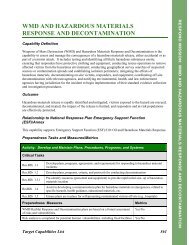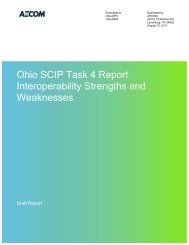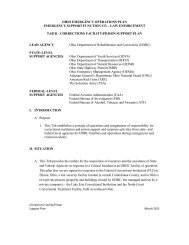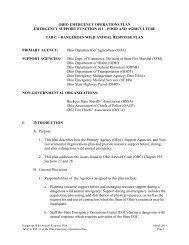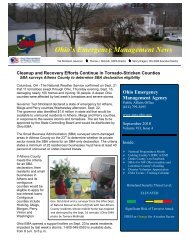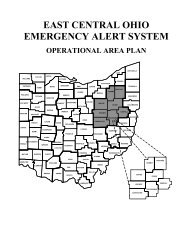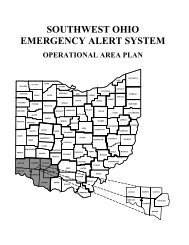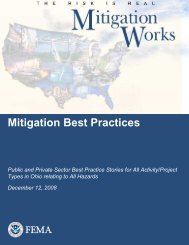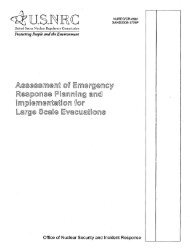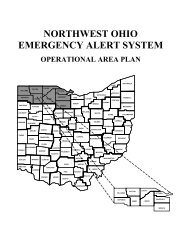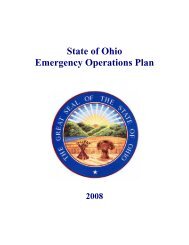PA Damage Assessment Field Guide - Ohio Emergency ...
PA Damage Assessment Field Guide - Ohio Emergency ...
PA Damage Assessment Field Guide - Ohio Emergency ...
- No tags were found...
Create successful ePaper yourself
Turn your PDF publications into a flip-book with our unique Google optimized e-Paper software.
OHIO EMAPUBLICASSISTANCEDAMAGEASSESSMENTFIELD GUIDE
INTENTIONALLY BLANK
The Purpose of the <strong>Damage</strong><strong>Assessment</strong> <strong>Guide</strong><strong>Damage</strong> assessment is the process whichdetermines the effects of a natural or humanmadedisaster. Specifically, Public Assistancedamage assessment determines the impact ofan event on public entities (cities, townships,counties, villages, schools and universities,special districts and authorities, etc.) andcertain private non-profit organizations (PNP).<strong>Damage</strong>s are captured in seven categories:debris removal, emergency protectivemeasures, roads and bridges, water controlfacilities, buildings and equipment, utilitiesand parks and recreation.This field guide has been designed to serve asa quick reference tool to be utilized by localofficials and others conducting local damageassessments for public entities and certainprivate non-profit organizations.
Why Do <strong>Damage</strong> <strong>Assessment</strong>?Each local assessment is essential indetermining:‣ What happened‣ The magnitude and impact of theevent‣ The effects‣ How much damage is there to theinfrastructure‣ Which areas suffered the greatestimpact‣ Which situations receive priority‣ What types of assistance areneeded (local, state, federal)‣ The identification of accuratedamage totals for reportingpurposes
Local <strong>Damage</strong> <strong>Assessment</strong> Must BeRapid, Detailed, and Accurate.‣ It should be completed and submittedto <strong>Ohio</strong> <strong>Emergency</strong> ManagementAgency (EMA) as soon as possiblefollowing an event. The data collectedwill then be analyzed to determine ifsupplemental assistance (physicaland/or financial) will be needed fromthe state and/or federal agencies.‣ If necessary, <strong>Ohio</strong> EMA will request aJoint Preliminary <strong>Damage</strong> <strong>Assessment</strong>(Joint PDA) with the Federal<strong>Emergency</strong> Management Agency(FEMA).‣ Delay in completing the assessmentcould delay supplemental disasterassistance to those most in need.‣ <strong>Assessment</strong> reports should be asaccurate as possible.
DO:‣ Conduct visual inspections to verifydamages and essential services thathave been effected.‣ Determine extent of insurancecoverage.‣ Use resources such as public works,county engineer, building officials, etc.to gather quality estimates of neededrepairs.‣ Identify critical infrastructure/facilitiesthat are affected by the event andassociated cost to restore.‣ Maintain documentation that identifiescosts incurred, and costs remaining.‣ Identify health and safety impacts andthe overall impact to the community.
DON’T:‣ Include costs not related to the event.‣ Include costs for deferred maintenance,pre-existing conditions, or wish listtype repairs.‣ Forget about your insurance coverage.‣ Count federal highways in yourdamage totals.‣ Rely on somebody else to assess thesituation. Plan ahead and know howyou are going to complete damageassessments for every event.‣ Think of it as ‘filling out paper workfor nothing’. Good damageassessments lead to accurate reportingand event situation awareness.‣ Exaggerate the amount of damage, as itwill be detrimental to the assessmentprocess
Documenting the <strong>Damage</strong><strong>Damage</strong> assessment starts at the local level.Local jurisdictions or counties can use thefollowing forms to document the disasterdamage estimates:<strong>Damage</strong> and Needs <strong>Assessment</strong> FormSite Estimate FormGathering information to complete the<strong>Damage</strong> and Needs <strong>Assessment</strong> Form shouldbe the first priority. Once that is completed, ajurisdiction can start using the Site Estimateforms to gain a more in-depth break down ofcosts.
<strong>Damage</strong> and Needs <strong>Assessment</strong> FormHelpful Hints‣ This is a summary of all your damagesby category and only the first page isrequired for Public Assistance <strong>Damage</strong><strong>Assessment</strong>.‣ This form needs to be sent into yourCounty EMA as soon as possible. YourCounty EMA will provide it to the<strong>Ohio</strong> EMA.‣ <strong>Damage</strong> <strong>Assessment</strong> is a continuousprocess. The numbers can be updatedas needed.‣ Record pertinent information that willimpact recovery.‣ Include requested budget information.
Site Estimate Form Helpful Hints‣ Category A: Debris Removal andCategory B: <strong>Emergency</strong> ProtectiveMeasures can each be a site reflectingjurisdiction-wide cost/impact.‣ All other categories should have a siteby facility unless they are like damages(i.e. chip and seal 20 miles of townshiproad jurisdiction-wide).‣ Use the amount of forms necessary toget an accurate representation of alldisaster damage estimates that haveoccurred in the jurisdiction.‣ Document all temporary andpermanent repairs by site and bycategory.‣ Describe the damage and impact forthe site and the percent complete.‣ Document populations affected,detours, loss of critical systems, etc., inthe impacted area.
Tips for Estimating Costs‣ Estimate hours and rates using yourown labor, equipment, and materials.Use FEMA Schedule of EquipmentRates for your own equipment. Note:Only Overtime for Category A and B‣ Request assistance from countyengineer.‣ Use contract estimates or historicalcost data from previous repairs orevents.‣ Estimate only costs that you will incur.Do not include costs from otheragencies. Deduct insurance proceeds.‣ Estimates should be based on return topre-disaster design, function, andcapacity.‣ Estimates for vehicles or contentsshould be based on the same typemake, year, model, and condition.
Public Assistance <strong>Damage</strong><strong>Assessment</strong> Category <strong>Guide</strong>linesThe following pages will break down theseven categories involved in capturing costsassociated with the event, along with adescription and examples of eligible activities.Documenting costs by category andjurisdiction will lead to an accuraterepresentation of total impact.
Category A: Debris RemovalPurpose:Debris removal is necessary to eliminateimmediate threats to life, public health andsafety; to eliminate threat of significantdamage to improved public or privateproperty; to ensure economic recovery of theaffected community; and to mitigate risk tolife or property by removing extensivelydamaged structures. Includes trees and woodydebris, sand, mud, silt, gravel, etc.Eligible Activities:• Debris removal from publically ownedstreets or highways to allow for thesafe passage of emergency vehiclesand the general public.• Debris must have been generated bythe disaster event.• Private property debris must bebrought to the curb or right-of ways.• Debris must be located on improvedproperty or right-of-ways.
Category A: Debris RemovalDebris Estimating FormulasEstimating Rule of Thumb:Cubic yards=CY15 trees, 8 inches in diameter = 40 CYSingle wide mobile home = 290 CYDouble wide mobile home = 415 CYRoot system (8’-10’ dia.) = One flatbedtrailer to moveTreat debris piles as a cube, not a cone, whenperforming estimates.FormulasBuilding formula:L’xW’ (building footprint) x No. of Stories x0.2 = _______CY of debrisDebris pile formula:L’xW’xH’= ______CY of debris.27
Category B: <strong>Emergency</strong> ProtectiveMeasuresPurpose:Measures taken before, during, and after adisaster to save lives, protect public health andsafety, and protect improved public andprivate property.Eligible Activities:• <strong>Emergency</strong> Operations Centeractivation (EOC)• Warning devices (barricades, signs,and announcements)• Fire, police, and search & rescue• Provision of shelters or emergencycare• Mutual aid or donated resources• Provision of food, water, ice, and otheressential needs• <strong>Emergency</strong> repairs, sandbagging• Removal of health and safety hazards• Track organized volunteer hoursduring the event. It could lead to alocal match offset.
Category C: Roads and BridgesPurpose:Repair to eligible facilities to include publicroads and bridges. To be eligible, roads andbridges cannot be part of a Federal-Aid systemor fall under authority of another jurisdiction.Eligible Activities:• Road surfaces, bases• Shoulders, ditches, and guardrails• Culverts• Low water crossings• Decking and Pavement• Slope protection• Drainage structures• Approaches• Piers• Girders and abutments• Determine extent of damage; what isneeded to return to pre-disaster design,function, and capacity.• If the road/bridge needs to becompletely shut down document:population affected, detour miles, andtime to complete repairs.
Category D: Water Control FacilitiesPurpose:Repair of irrigation systems, engineereddrainage channels, and pumping facilities.Repair of levees, dams, and flood controlchannels fall under Category D, but theeligibility of these facilities is restricted. USArmy Corp of Engineers (USACE) andNatural Resources Conservation Service(NRCS) have primary authority for floodcontrol works.Eligible Activities:• Channel alignment• Recreation• Navigation• Land reclamation• Fish and wildlife habitat• Interior drainage or Irrigation• Erosion prevention• Flood control• Did facility cause flooding or damageto adjacent properties?• Did you need to evacuate? How many?
Category E: Building and EquipmentPurpose:Repair or replacement to eligible facilities toinclude public or PNP buildings, structuralcomponents, interior systems, equipment,vehicles, and content. The public entity mustbe responsible for the repair or replacement.Eligible Activities:• Buildings, including contents such asfurnishings and interior systems.• Replacement of pre-disaster quantitiesof consumable supplies and inventory.• Replacement of library books andpublications.• Removal of mud, silt, or otheraccumulated debris.• Equipment and vehicles may beeligible for repair or replacement ifdamaged as result of an event.• Estimates based on return to predisasterdesign, function, and capacity.• Determine insurance coverage.
Category F: UtilitiesPurpose:<strong>Damage</strong> to public or PNP utilities can impactthe community’s ability to respond andrecover after the event and may cause healthand safety risks when services are disrupted.Repair to these facilities are crucial andeligible unless repairs are the responsibility ofanother entity.Eligible Activities:• Water treatment and delivery facilities• Power generation facilities• Sewage collection and treatmentfacilities• Natural gas systems• Communication systems• Substations/power lines• Temporary and permanent repair costs• Restoration costs• Determine amount of insurancecoverage.• Estimates based on return to predisasterdesign, function, and capacity.
Category G: Parks, Recreational, andOtherPurpose:<strong>Damage</strong> to parks, recreational, and otherfacilities can impact the community’s abilityto respond and recover after the event.Consideration should be given to securing thedamaged areas from public access.Eligible Activities:• Public mass transit facilities• Playground equipment, swimmingpools, tennis courts, and recreationfields• Boat docks, ramps, and piers• Public-owned golf courses• Fish hatcheries• Determine amount of insurancecoverage.• Estimates based on return to predisasterdesign, function, and capacity.Facilities that do not fit into categories C-Ffall in this category. PNP-owned parks andrecreational facilities are not eligible.
Resource Information<strong>Ohio</strong> EMA Recovery Branch: (614) 799-3665Public Assistance Program:http://ema.ohio.gov/Recovery_<strong>PA</strong>GrantProgramFEMA Schedule of Equipment Rates:http://www.fema.gov/government/grant/pa/eqrates<strong>Ohio</strong> EMA Assistance Tool Box:http://ema.ohio.gov/Recovery_DAToolbox
Contact Numbers:
Notes:
<strong>Ohio</strong> <strong>Emergency</strong> Management Agency2855 West Dublin-Granville RoadColumbus, OH 43235www.ema.ohio.gov4/2012



